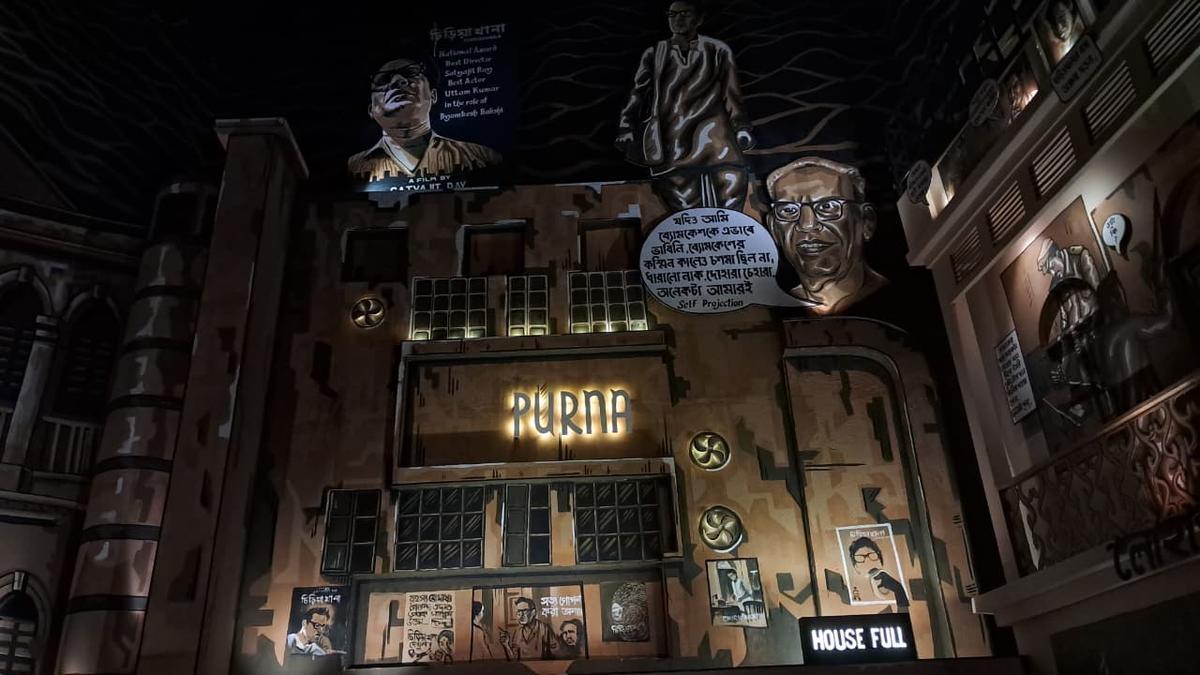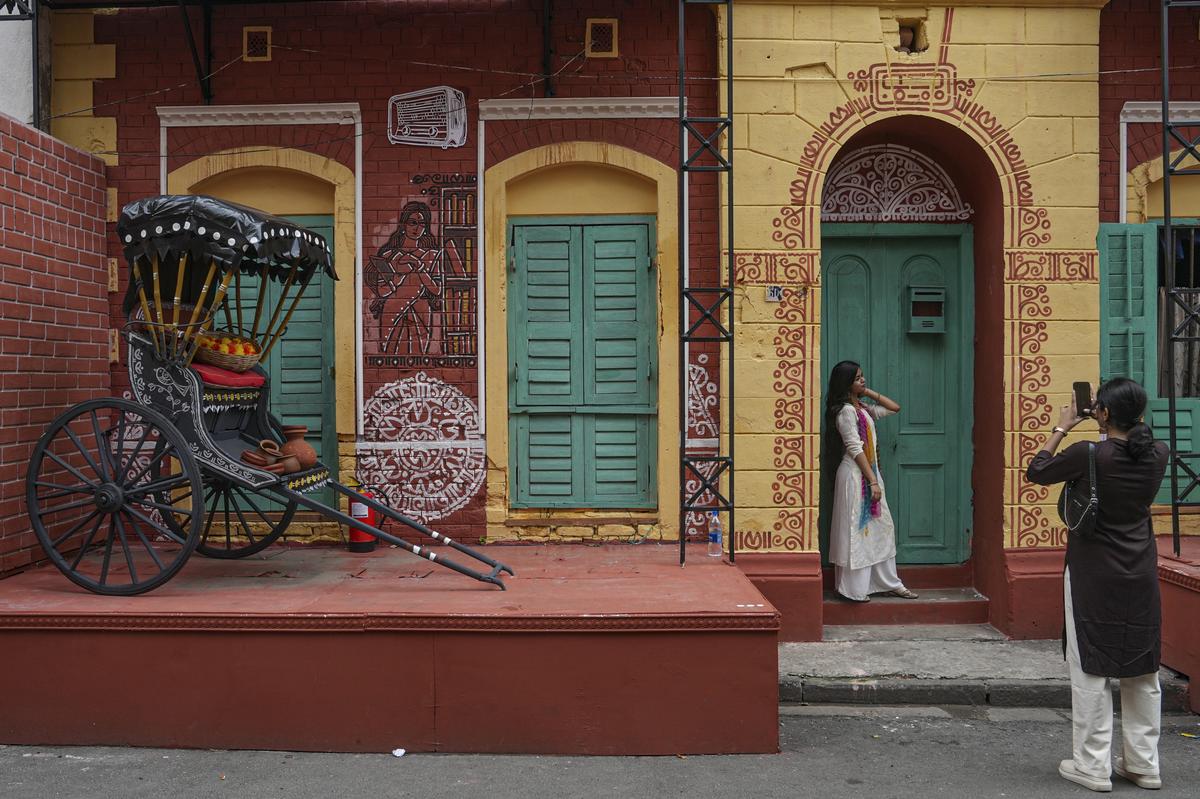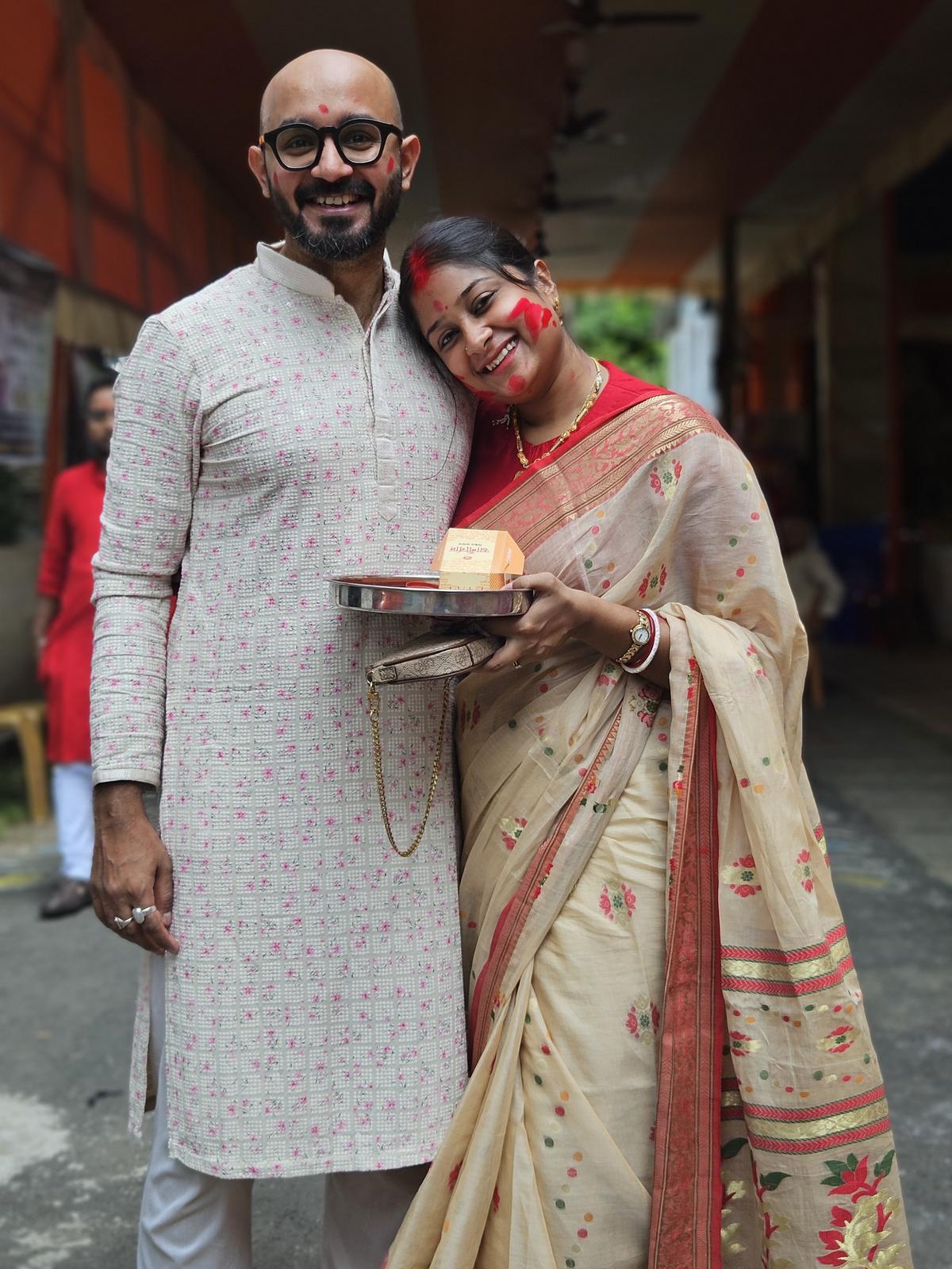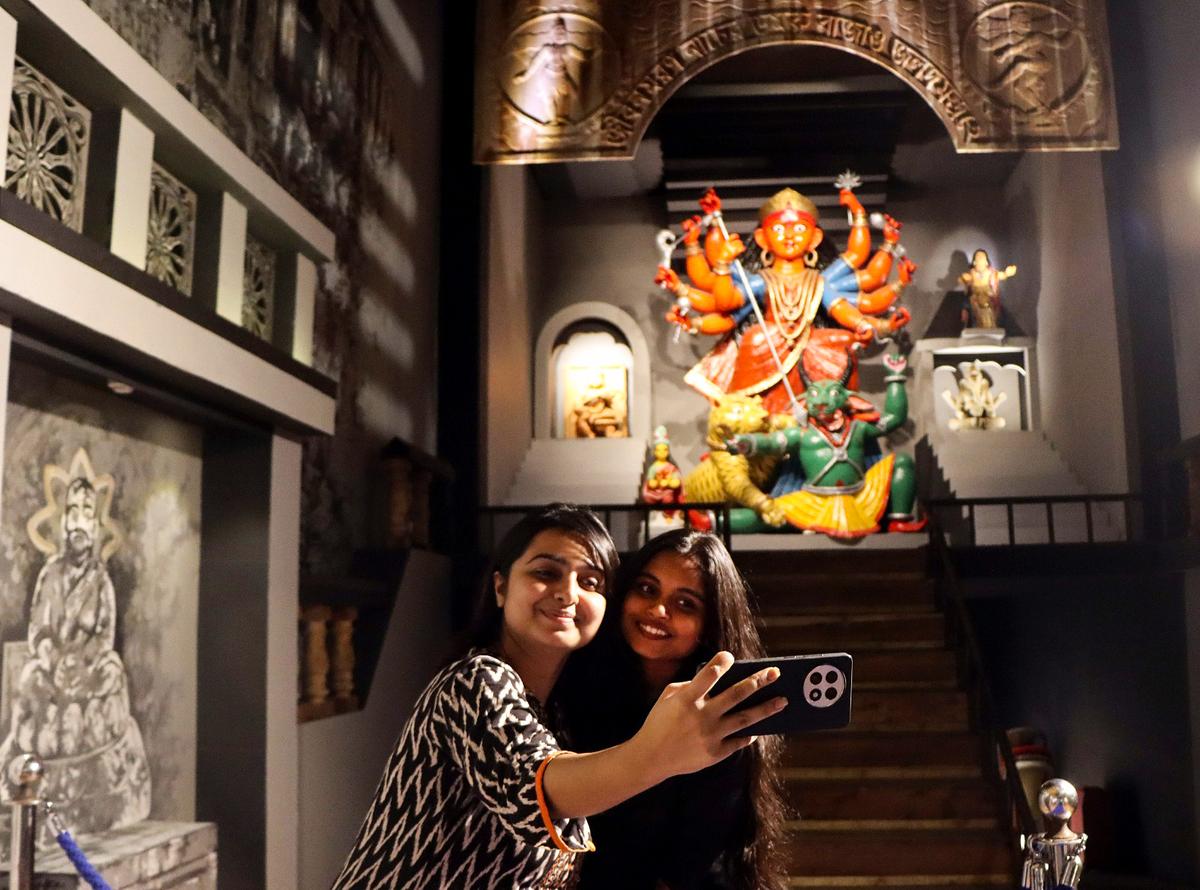Dakshindari Youth Durga Puja in South Dum Dum — dedicated to acid attack survivors
Kolkata’s streets and the pursuit of love during Durga Puja are cut from the same cloth, a fabric of chance and inevitability. Every wrong turn might open like a trapdoor — into an ornate, never-seen-before pandal, or into the orbit of a stranger whose glance lingers a heartbeat too long in the bhog (offering) queue. The newness of the season feels conspiratorial: the thrill of a first encounter or a perfectly timed meet cute. Or on Navami, when the smoke of Sandhi Puja coils around the fading festivities, there is a lingering ache, a reminder of a love that never quite blossomed. By Dashami, as the goddess herself departs for her sojourn, one might even be ghosted by the Hinge date who promised so much.
For generations, Durga Puja has been more than a festival. It has been Kolkata’s most democratic stage for social life, a space where young men and women exchanged glances at Maddox Square, or struck up conversations under the neon lights of Ballygunge Cultural. It was, in many ways, Bengal’s original social network, its first dating app even.

Dum Dum Tarun Dal pandal
The city has changed, and the pandals with it — simple structures now reborn as spectacles fit for a biennale but the pulse remains. Parents who once found love in puja clubs have children who swipe right before stepping out to hop pandals. Courtship has shifted from adda to algorithm, yet pujo remains Kolkata’s canvas for encounters both old and new.
“I remember seeing him for the first time at a pujo pandal,” recalls 57-year-old Anisha Shaw (name changed), who met her husband, Ashish Basu (name changed), at Shib Mandir’s puja pandal in 1996. “Pujo was simpler then. We friends circled around the pandal for hours of adda (conversation), helped with the bhog, ferried buckets of water, and fried beguni (aubergine fritters) in giant kadhais (utensils). Someone’s cousin would be sent running to Gariahat to fetch more mustard oil or kasundi (mustard). It was that kind of Pujo. Ashish and I kept running into each other. A year later, we were married.”

Mishka Basu
In contrast, Anisha’s daughter, 27-year-old sous chef Mishka Basu (name changed), met her fiancé on Bumble in 2024. Their romance began with a right swipe and a first date at AM PM on Park Street. Where their parents’ love story unfolded between alpanas and serving tables, theirs began in an app’s chat window.
Algorithms before anjali (prayers)
“So in your world, multiplication is the same as division?” That was the first line 29-year-old engineer Arpan Majumdar sent to 26-year-old IT-healthcare professional Sailanki Nandy on Tinder — a witty reference to her microbiology background. “In cell biology, ‘division’ is when a parent cell splits into two daughter cells, which actually multiplies their number,” she explains. “I melted right then,” Sailanki laughs. “I’d chatted with so many boys, but no one bothered to write something clever like that. Now people use AI-generated lines.”
Sailanki had dabbled in dating apps like Bumble and OkCupid during college, logging in “for a bit of validation” and deleting them after a few days. But in the long, lonely months of COVID-19 in 2020, she decided to give Tinder a serious try.

A young woman poses for pictures at a Durga Puja pandal, themed on the ‘Maha Alaye Maa’, in Kolkata
| Photo Credit:
Manvender Vashist Lav
“Arpan was staying at his sister’s house in Jadavpur, and I was in Behala. He’s from Barrackpore, but our radii overlapped, and we matched,” she recalls.
Durga Puja, she says, has always held deep meaning. “I grew up in a joint family. Puja meant cousins coming back to the city followed by loud, festive days.” Their first pujo together was in 2021. “We planned to meet on Ashtami — me in a sari, him in a panjabi (kurta). But he got food poisoning on Saptami. I told him to rest, but that night he insisted, ‘Chol, North Kolkata te thakur dekhte jai’ – let’s go see the pandals in North Kolkata. I thought he was crazy. He travelled from Barrackpore despite being unwell, just so we could meet. We queued for one big pandal, but I said, ‘If you need a loo break, we’ll be stuck in a sea of people!’ So we ducked into a café nearby, sitting close to the restroom, laughing about it.”
On Dashami morning they finally went pandal-hopping in South Kolkata, and afterward Arpan came home to meet her family. “That was our first Pujo together,” she says.
“He is the kindest person I’ve ever met — so genuine. His Tinder opening line still makes me smile silly. Next year we are getting married. This Pujo we will be back in Kolkata to talk about our wedding,” Sailanki adds.
User behaviour
Speaking about dating patterns during the festive season, Chandni Gaglani, Indian dating app Aisle’s head of business observes clear “pre- and post festival” waves. “We see intense intent setting,” she explains. “People update bios, refine filters, even tweak distance or language preferences to short list matches before celebrations begin. Usage frequency spikes, then dips once Durga Puja is in full swing, when everyone is absorbed in family and community. After the festival, there’s a beautiful reflection period.”
Chandni notes that social, community-driven festivals exert a very different pull than global occasions such as Valentine’s Day. “These moments are deeply cultural and rooted in belonging,” she says. “They tap into something fundamental about identity and community.”
Kolkata, she adds, sees the highest female participation on the dating app. “The city has always had a romantic, intellectual culture where relationships are treated as serious endeavours. We see that in how thoughtfully users craft profiles and conversations,” remarks Chandni.
Aisle’s users range from ages 18 to 50, but the largest group is the 26 to 35 demographic most inclined toward long term commitment. “This cohort has typically moved away from their hometowns, established careers, and now seeks meaningful partnerships on their own terms,” Chandni explains.
On the technology side, she emphasises that Aisle’s algorithm “takes signals from user activity and adapts accordingly, but the choice and control always remain with our users.” The app’s For You section is curated not just by age or location, she says, but by “shared values and interests. Such signals raise the odds of real compatibility rather than simply showing everyone who fits broad criteria.”

Raja Ravi Varma inspired pandal in Tricone Park
Across Age Groups
Thirty-eight-year-old Purnendu Guha (name changed), a reporter in Kolkata, has been using dating apps since 2020, a year after his divorce.
“Being a reporter, I don’t have enough time to go out on dates, and I can’t really date people from my workplace,” he says. “But meeting someone during pujo is different. Across those five days, I get to interact with the person thoroughly, see how they respond to art, how they interact with people, handle money while buying from vendors, and if they’re checking other people out,” he laughs.
“For me, pujo makes dating safer too since it’s all in public spaces. I have been doing this every year since 2020. No encounter has culminated into a relationship yet, but I’ve made good friends who share my values and my interest in art. When you meet someone in a café, the time is short, and the conversation stays on the surface. But during pujo, with longer hours and constant brushes with culture and art, I find both of us open up more.”
This year, he already has a plan. “I’m meeting my date at a Raja Ravi Varma themed pandal in Tricone Park,” he says, smiling. “I already have butterflies!”
Speaking of how pujo has changed, 33-year-old software engineers Kaustav and Arjoyita Banerjee recall a different time. The two began dating in 2010 after sparking a romance on Orkut.
“Back then, you could actually stand in front of a pandal and take it all in,” Kaustav says. “Now it’s near stampede crowds, you barely get a moment to look at the decorations, let alone meet someone new.” After a decade of dating and six years of marriage, the couple now prefers hosting a house party during pujo instead of braving the crush outside.
A sense of anonymity still matters, says Megha Palit, a 34-year-old event planner and lesbian who meets women mostly through dating apps. “Hinge is where the first hello happens,” she explains, “but pujo is where you find out if the chemistry is real. You can wander Maddox Square at midnight, hold someone’s hand, and no one knows whether you’re just friends or something more.”
She remembers her college years, long before swipes and matches, when Durga Puja was the only place she could risk a cheeky flirtation with another woman. “It’s crowded, anonymous, and oddly protective,” she says. “The city is so busy worshipping the goddess it forgets to police you. Even now, after we’ve matched online, that’s where I take a date first. In the middle of the lights and the dhak, you can breathe and maybe fall a little in love.”

Sreejita and Aditya
Sreejita Chakraborty, a 28-year-old entrepreneur, and her 32-year-old husband, Aditya Sengupta, a sales strategist, met on Tinder in 2021.
“Being a Bengali who grew up in Delhi, pujo for me always meant four packed days at CR Park,” Aditya says.
“Sreejita is from Kolkata and my first pujo with her was so special,” recalls Aditya. After their marriage, he remembers a moment that stayed with him, “As our flight descended upon the Kolkata skyline, the bright lights below felt like they were speaking to me.”
Over the years, as their relationship deepened, Pujo has taken on a richer meaning. “It’s not just about romantic love,” he says. “Now it’s about wheeling my 90-year-old grandmother through the pandals, because the joy of discovering new pandals and appreciating the artistry of each means little unless it’s shared with family,” smiles Aditya.
Kolkata has always left its doors ajar for mystery and awe to wander in. Durga Puja takes the heart of its people and blurs the range of immersive experiences each year. The goddess comes and goes but leaves behind a thousand small awakenings. Apps may start the conversation now, but the real magic still happens under those restless, fevered nights when Kolkata forgets itself and remembers desire.

Girls click a selfie
| Photo Credit:
ANI

